ASRock X58 Extreme - $169.99 is not too Extreme
by Gary Key on July 2, 2009 12:00 PM EST- Posted in
- Motherboards
Test Setup
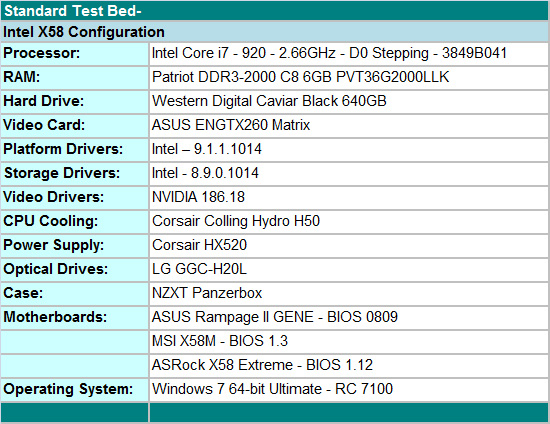
We selected the ASUS ENGTX260 video card for GPU duties. It is a non-reference design that offers improved thermals and acoustics over the standard NVIDIA GTX260 216 designs. The WD Caviar Black 640GB is our hard drive of choice for storage purposes. LG’s GGC-H20L Blu-ray playback capable drive fills in for optical duties. We utilized Patriot’s DDR3-2000 C8 6GB kit for memory duties. We use 6GB in our standard benchmarks with memory set at DDR3-1600 with 7-8-7-20 1T timings at 1.6V.
We chose the new Corsair Hydro Series H50 CPU cooler for thermal duties and it worked very well in our NZXT Panzerbox. Our standard power supply is the excellent Corsair HX520 and considering our standard test bed is limited to a single video card, this power supply is perfectly suited for us. Finally, we have dropped Vista 64 and moved to Windows7 64-bit RC for our testing today, it just works better.
Overclocking
ASRock considers the X58 Extreme an entry level X58 motherboard with the capability to overclock in a similar fashion to boards costing up to $80 more. They are correct for the most part. There are definitely boards that will hit higher Bclk rates and offer better memory clocking, but we are concentrating on mainstream overclocking abilities in our tests. We focus on the type of overclocks that support 24/7 operation with reasonable cooling alternatives and the ability to run a multitude of programs without a problem. We are not optimizing for Super Pi or 3DMark records.
We put an emphasis on stability during our testing sessions so we test with real world applications ranging from a variety of games to digital imaging software to various audio/video creation programs, along with the typical OCCT and PCMark Vantage tests.
i7 920 D0 6GB Results
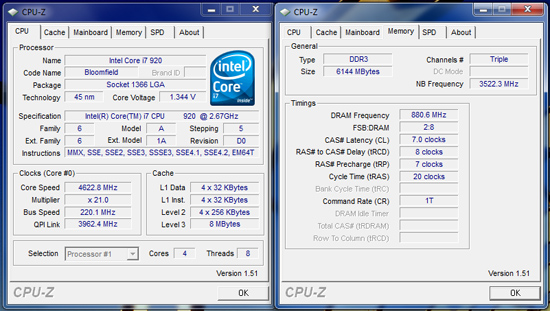
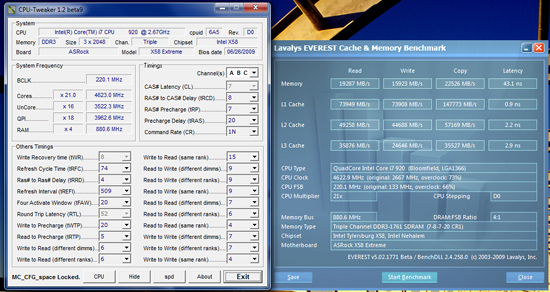
Our maximum 24/7 overclock using our cooler selection with the i7 920 D0 resulted in a 4.62GHz clock speed at a respectable 220 Bclk. The 6GB Patriot memory kit is set to DDR3-1760 at 7-8-7-20 1T timings. The primary voltage settings were 1.38V Core VID, 1.41V VTT, 1.85V PLL, 1.65V VDimm, and PCIe at 105MHz. We tried to enable basic power management options (SpeedStep/CState) so idle Core VID voltages could be reduced to the 1.18V range, but we just could not do it and maintain stability at this setting compared to other boards we have tested.
Dropping down to a much easier 24/7 friendly 21x200 (4.2GHz) setting allowed us to run all power management features without a problem at lower voltages. In fact, 21x210 (4.4GHz) was fine also although we had to run the same CPU voltage offset as we did at 4.6GHz. Core Vdroop was approximately -.04V with the Vdroop setting disabled and is our recommended setting. Maximum Bclk that we have reached on the board with standard cooling is 230 (19x230, 4.33GHz) straight from the BIOS, however, memory settings had to be relaxed to 9-9-9-24 at DDR3-1840 for stability. ASRock is continuing to fine tune memory performance on this board, even though the CAS difference does not adversely affect application performance, just the synthetic benchmarks.
i7 920 D0 High Clock Low Volt Results
While overclocking is an important and fun measurement of a board’s capability, we also realize that undervolting can be just as important to others. As such, we devised a quick multitasking test that allows us to push our systems with real world applications that stress the GPU, CPU, Memory, and Storage subsystems. We load up Sony Vegas Pro 9.0 64-bit and set it to transcode a 1080P video while running our FarCry 2 loop benchmark at 1680x1050 2xAA DX10 High Quality in window mode. Average CPU usage is 98% throughout this process with HT enabled.
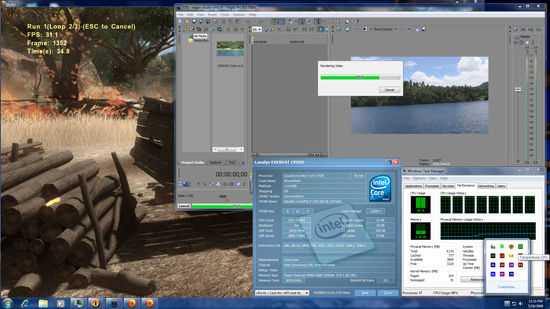
The ASRock X58 Extreme passed our full test suite at 21x160 for a final 3.37GHz core speed. We enabled the BIOS with full power management options and Core Vid at 1.15V (with offset) resulting in an idle voltage of 0.880V and full load voltage at 1.016V. VTT was set to 1.2V and VDimm at 1.60V with memory timings at 7-8-7-20 1T for DDR3-1600 speeds.
DPC Latency
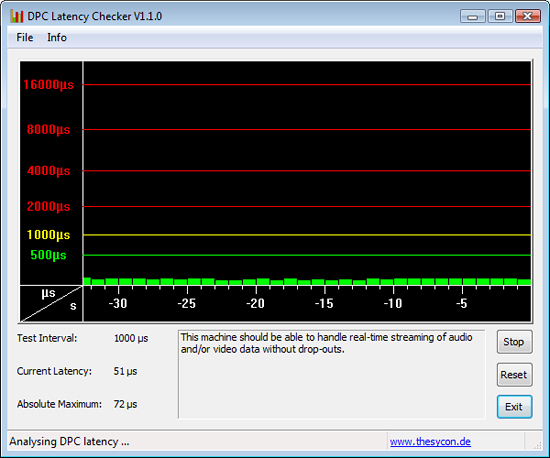
We receive numerous requests for DPC latency results on each board we test. The ASRock X58 Extreme passed with flying colors using our stock settings at 21x133, but with 12GB of memory at DDR3-1600 with 8-8-8-24 1T timings.
















44 Comments
View All Comments
SunSamurai - Thursday, July 2, 2009 - link
Gary Key, if this were not a tech site then such aesthetics would not really matter, but seeing as this IS a tech site and one might ponder credibility, please use the appropriate codecs!Thank you and another great article.
Ryun - Friday, July 3, 2009 - link
Why is .jpg bad? I'm legitimately curious.UNHchabo - Thursday, July 2, 2009 - link
For tables, .png files would likely be smaller, too.DeepThought86 - Thursday, July 2, 2009 - link
How about adding a 24 100% load stability test for all motherboard reviews. It would really be useful to get a feel for the motherboard's quality and VRM robustness.Use the highest clocked supported proc and see if anything crashes.
Gary Key - Friday, July 3, 2009 - link
We loop various applications (multitask) to keep CPU utilization above 95% on all cores at our overclock settings for approximately 100 hours of actual testing and 200 hours at stock settings. We do this to ensure the entire platform is being stressed and not just one particular area such as the CPU (memory to some degree) with various programs like LinX (Linpack front end), OCCT, and others that concentrate on the CPU.While these programs will also stress the VRM to some degree, in some instances,LinX to be exact,tend to overstress it based on the original Linpack requirements. That is fine for short burst testing but for long term testing it does not represent anything close to the actual VRM loads your system will experience.
That said, we do run all of the various CPU buster programs, but they are just that, CPU centric. We can pass certain hour points that people tend to think is stable with these programs and then watch our first multitask test tank in a few minutes. I tend to stress everything on the platform with actual apps (single/multitask) and call it a day if everything I run does not crash over a 100 hour period.
In the full review I will list out our testing methodology in more detail. Also note, every board, memory, and CPU combination is different. We tend to spend the first day or two with a board dialing all the various components in so the CPU is in the "Zone" when overclocking.
Ryun - Thursday, July 2, 2009 - link
I've known about Asrock for awhile and I see these great boards from them, but they're so hard to recommend because they don't really have much of warranty to speak of. I just put an Asrock 760g in my brother's new computer and the system runs great, cool, and has a wealth of BIOS options.I'd like to get one for myself in the future but the 1-year-return-to-the-retailer-warranty just prevents me from spending anymore than around $80 on one of their boards, let alone $170.
Arbie - Thursday, July 2, 2009 - link
Perceptions of value are relative and everyone has their own standards. But right before reading this comment I was thinking: how can a company produce a piece of technology like this and sell it retail for $170? The design effort, manufacturing equipment, parts cost, build, testing, packaging, documentation, shipping AND the warranty - not to mention dealer profit - make this seem incredible. And that's taking for granted the supporting tech / price achievements of the component suppliers.
Look at what you're getting - the heart of a strong PC that can outperform any computer in the world of 15 years ago, and do it 24/7 for the next 15 years if you ask it to. In contrast, $80 is two tanks of gas.
Really - successfully mass-producing something like this IS rocket science. We tend to lose sight of that fact and fail to appreciate what this industry is doing for us. We need to stop and smell the surface-mount devices once in a while.
If a motherboard is reliable and has the features I want, I'm not going to worry about these differences in price. The true value of the finished PC, to me at least, is many thousands of dollars. Saving $100 or $200 on the motherboard is not important in comparison, and I wouldn't want to have done so. And that's my recommendation for anyone else who would be reading this column.
Arbie
Ryun - Thursday, July 2, 2009 - link
I agree with what you say almost to the letter, but I'm just a more cynical buyer I suppose. My philosophy is that any company that can create a good product can also have a terrible one come off the production line and I just like the companies that I buy from to be accountable and aware of that.If Asrock offered a 3 year warranty there'd be no contest for me. Hell, even if they offered 2 years I'd be happy. You say that we tend to lose sight of the importance of these devices and you're absolute right, most do. I'm just really jaded and skeptical of a products quality no matter where it comes from. I also suspect that the both of us might be different in our financial situations as well. I'm a student that doesn't make much money so if I were to buy an $170 board and it blows after 1 year I'm computer-less.
ap90033 - Thursday, July 2, 2009 - link
Hey is there going to be a guide to help us noobs out here OC our i7 920 Rev D0? There are a zillion settings, and it is to much money to monkey around with without any real guidance.Gary Key - Friday, July 3, 2009 - link
I discussed it with Raja this morning and due to the interest in a "How To" article, we will team up and do one together later this month after I get this floating pile of motherboards reviewed. ;)